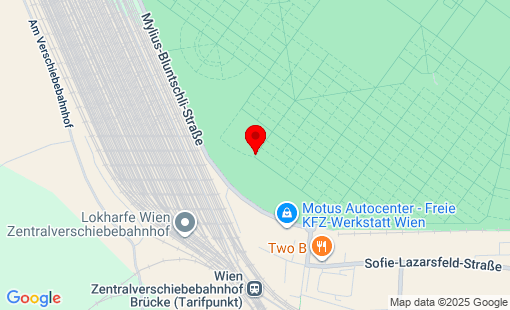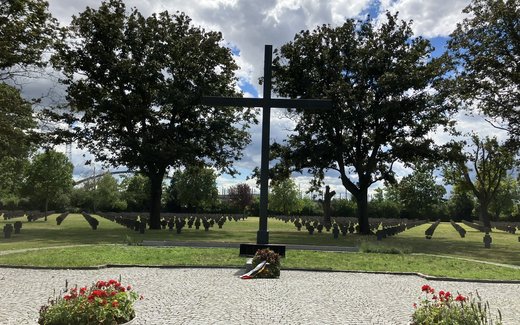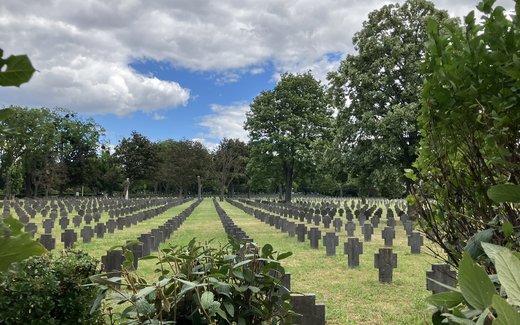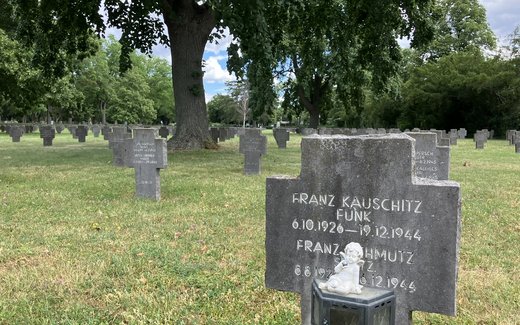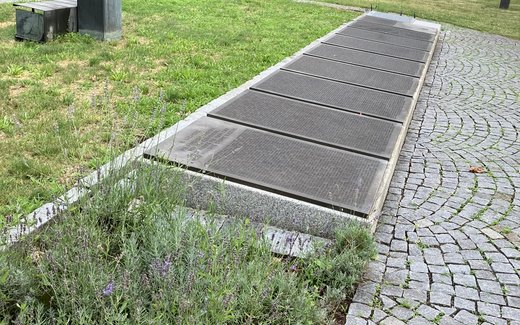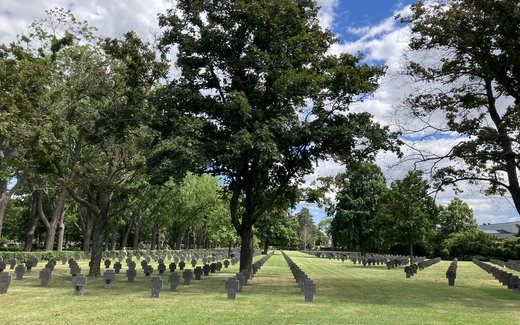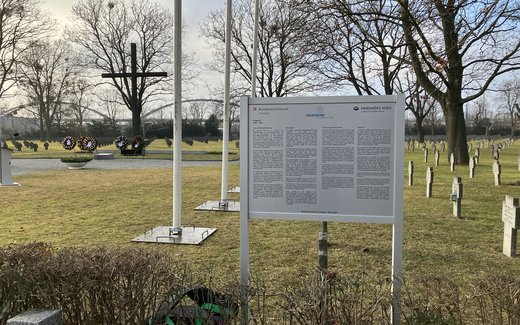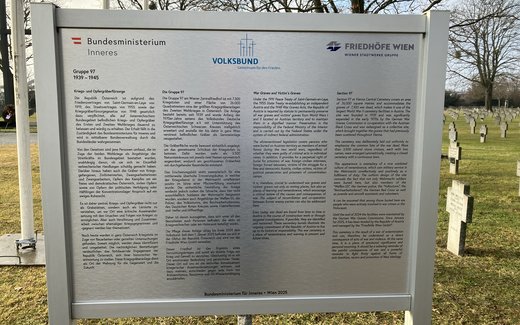The largest German war cemetery of the Second World War in
Austria is located at the Vienna Central Cemetery.
Cemetery description
Opened in 1874, it is one of the largest cemeteries in Europe with around three million
330.000 graves, it is one of the largest cemeteries in Europe. The German
War cemetery forms group 97 in the south of the cemetery. From the
Main entrance (Gate 2) it is just under 1.5 kilometers on foot, from Gate 9
on Mylius-Bluntschli-Straße only around 300 meters. A bus runs from the
From the main entrance on a circular route with 19 stops (public transport tickets)
Public transport tickets). The German war cemetery is around 26,000 square meters in size
large.
On a continuous lawn area, the Volksbund Deutsche
War Graves Commission placed over 3,500 natural stone crosses to mark the graves
Natural stone crosses, each bearing the names of two deceased. On the
Memorial square in the center of the cemetery stands a forged high cross, which is
framed by a semi-circular lawn. Behind it are plaques
with the names of the over 1,000 dead who could no longer be recovered or identified
could be identified.
Occupancy
The total losses of the Wehrmacht in Austria are estimated at over 45,000
Human lives. In the final phase of the war, Vienna was also the scene of
fierce fighting. The dead buried at the Central Cemetery are primarily
primarily Germans who died in the city and the dead who were initially buried in cemeteries further afield
initially buried in cemeteries in the wider area - of the 52 suburban cemeteries in Vienna
Suburban cemeteries, around 2,000 German war dead were buried here.
Soldiers of the Wehrmacht are buried here as well as anti-aircraft gunners and
-helpers, members of the Waffen-SS, police, Volkssturm and Reich Labor Service,
German Red Cross ... There are around 7,300 in total.
History
The site has existed since 1939 and was expanded and redesigned between 1969 and 1975
extended and redesigned. The Volksbund inaugurated the cemetery on 25.
October 1975.
There is no war graves agreement between Germany and Austria. The
Basis of the Volksbund's work in Austria are the Austrian war graves
War Graves Commission Act of 1948 and the State Treaty of 1955 on the restoration of an
Restoration of an independent and democratic Austria. Since the
The end of the 1960s, the Volksbund, with the approval of the
Federal Ministry of the Interior, the Volksbund has established eleven cemeteries throughout Austria for
german war dead of the Second World War. In the process, it recorded more than
30.000 graves. In the course of the reburials, many previously unknown dead were
were subsequently identified.
As the last German war cemetery in Austria, the War Graves Commission has
Cemetery at the central cemetery into Austrian care at the beginning of 2025
into Austrian care.
Since then, a plaque reads: "This cemetery is the result of a war of extermination
War of extermination and therefore a direct consequence of war and violence
and violence. At the same time, it is a place of emotional significance and personal
Mourning. This place should remind us of the painful consequences of war
And remind us to resolutely oppose all forms of anti-Semitism, racism
Anti-Semitism, racism and Nazi reactivation.
Special feature
Due to its many graves of honor, the Art Nouveau buildings and the
Art Nouveau buildings and the extensive grounds make it one of the city's
Sights of the city of Vienna.
In the vicinity of the German war cemetery rest members of other
Nations who lost their lives as soldiers in both world wars. In group 91
lie the Austro-Hungarian soldiers who died in the First World War.
Serbian soldiers who died in the First World War are buried in group 93
are buried here. Directly adjacent to this cemetery is Group 88, which contains the
polish and French war dead of the First World War as their final resting place
Final resting place. Group 68A contains Russian, Romanian and Italian victims of the First World War
Victims of the First World War. Soviet war dead of the Second
World War II are buried in Group 44.
